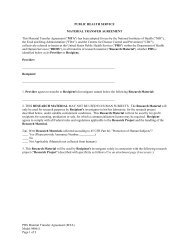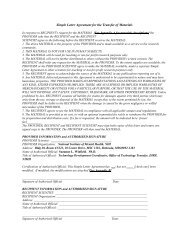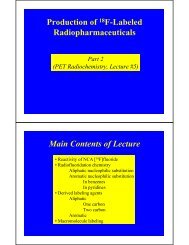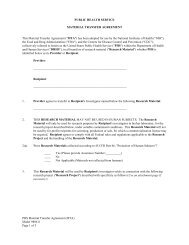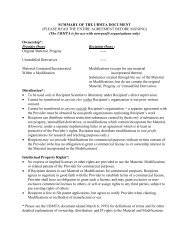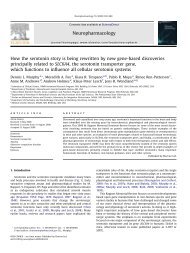Radiodefluorination of 3-Fluoro-5 - NIMH Division of Intramural ...
Radiodefluorination of 3-Fluoro-5 - NIMH Division of Intramural ...
Radiodefluorination of 3-Fluoro-5 - NIMH Division of Intramural ...
Create successful ePaper yourself
Turn your PDF publications into a flip-book with our unique Google optimized e-Paper software.
Supplemental Material can be found at:http://jpet.aspetjournals.org/cgi/content/full/jpet.108.143347/DC10022-3565/08/3273-727–735THE JOURNAL OF PHARMACOLOGY AND EXPERIMENTAL THERAPEUTICS Vol. 327, No. 3U.S. Government work not protected by U.S. copyright 143347/3411023JPET 327:727–735, 2008Printed in U.S.A.<strong>Radiodefluorination</strong> <strong>of</strong> 3-<strong>Fluoro</strong>-5-(2-(2-[ 18 F](fluoromethyl)-thiazol-4-yl)ethynyl)benzonitrile ([ 18 F]SP203), a Radioligandfor Imaging Brain Metabotropic Glutamate Subtype-5Receptors with Positron Emission Tomography,Occurs by Glutathionylation in Rat BrainH. Umesha Shetty, Sami S. Zoghbi, Fabrice G. Siméon, Jeih-San Liow, Amira K. Brown,Pavitra Kannan, Robert B. Innis, and Victor W. PikeMolecular Imaging Branch, National Institute <strong>of</strong> Mental Health, National Institutes <strong>of</strong> Health, Bethesda, MarylandReceived July 9, 2008; accepted September 18, 2008ABSTRACTMetabotropic glutamate subtype-5 receptors (mGluR5) are implicatedin several neuropsychiatric disorders. Positron emissiontomography (PET) with a suitable radioligand may enable monitoring<strong>of</strong> regional brain mGluR5 density before and during treatments.We have developed a new radioligand, 3-fluoro-5-(2-(2-[ 18 F](fluoromethyl)thiazol-4-yl)ethynyl)benzonitrile ([ 18 F]SP203),for imaging brain mGluR5 in monkey and human. In monkey,radioactivity was observed in bone, showing release <strong>of</strong> [ 18 F]-fluoride ion from [ 18 F]SP203. This defluorination was not inhibitedby disulfiram, a potent inhibitor <strong>of</strong> CYP2E1. PET confirmedbone uptake <strong>of</strong> radioactivity and therefore defluorination <strong>of</strong>[ 18 F]SP203 in rats. To understand the biochemical basis fordefluorination, we administered [ 18 F]SP203 plus SP203 in ratsfor ex vivo analysis <strong>of</strong> metabolites. Radio-high-performanceliquid chromatography detected [ 18 F]fluoride ion as a majorradiometabolite in both brain extract and urine. Incubation <strong>of</strong>[ 18 F]SP203 with brain homogenate also generated this radiometabolite,whereas no metabolism was detected in whole bloodin vitro. Liquid chromatography-mass spectrometry analysis <strong>of</strong>the brain extract detected m/z 548 and 404 ions, assignable tothe [M H] <strong>of</strong> S-glutathione (SP203Glu) and N-acetyl-S-Lcysteine(SP203Nac) conjugates <strong>of</strong> SP203, respectively. Inurine, only the [M H] <strong>of</strong> SP203Nac was detected. Massspectrometry/mass spectrometry and multi-stage massspectrometry analyses <strong>of</strong> each metabolite yielded productions consistent with its proposed structure, including theformer fluoromethyl group as the site <strong>of</strong> conjugation. Metabolitestructures were confirmed by similar analyses <strong>of</strong>SP203Glu and SP203Nac, prepared by glutathione S-transferasereaction and chemical synthesis, respectively. Thus,glutathionylation at the 2-fluoromethyl group is responsiblefor the radiodefluorination <strong>of</strong> [ 18 F]SP203 in rat. This studyprovides the first demonstration <strong>of</strong> glutathione-promoted radiodefluorination<strong>of</strong> a PET radioligand.Downloaded from jpet.aspetjournals.org at NIH Library on February 26, 2009Metabotropic subtype-5 receptors (mGluR5) have a discretedistribution in brain and are a potential target fortreating several neuropsychiatric disorders, including schizophrenia(Pietraszek et al., 2007), Alzheimer’s disease (TsaiThis work was supported by the <strong>Intramural</strong> Research Program <strong>of</strong> NationalInstitutes <strong>of</strong> Health (National Institute <strong>of</strong> Mental Health project Z01-MH-002795-04). A portion <strong>of</strong> this work was presented at the 55th American Societyfor Mass Spectrometry Conference on Mass Spectrometry and Allied Topics,2007 Jun 3–7, Indianapolis, IN.Article, publication date, and citation information can be found athttp://jpet.aspetjournals.org.doi:10.1124/jpet.108.143347.et al., 2005), anxiety (Brodkin et al., 2002), depression (Li etal., 2006), drug addiction (Kenny and Markou, 2004), andfragile X syndrome (Dölen et al., 2007). Potent noncompetitivemGluR5 antagonists, such as 6-methyl-2-(phenylethynyl)pyridine(Gasparini et al., 1999) and 3-[(2-methyl-1,3-thiazol-4-yl)ethynyl]pyridine (Cosford et al., 2003), have beendeveloped. Nevertheless, a useful drug is yet to emerge fromthese antagonists for treating any <strong>of</strong> the implicated neuropsychiatricdisorders. Selective imaging <strong>of</strong> mGluR5 in livinghuman brain with a suitable radioligand and a techniquesuch as positron emission tomography (PET) is needed toABBREVIATIONS: mGluR5, metabotropic glutamate subtype-5 receptor(s); PET, positron emission tomography; SP203, 3-fluoro-5-(2-(2-(fluoromethyl)thiazol-4-yl)ethynyl)benzonitrile;[ 18 F]FCWAY, 18 F-trans-4-fluoro-N-(2-[4-(2-methoxyphenyl)piperazin-1-yl)ethyl]-N-(2-pyridyl)cyclohexanecarboxamide;[ 18 F]SP203, 3-fluoro-5-(2-(2-[ 18 F](fluoromethyl)thiazol-4-yl)ethynyl)benzonitrile; HPLC, high-performance liquid chromatography;LC-MS, liquid chromatography-mass spectrometry; MS/MS, mass spectrometry/mass spectrometry; amu, atomic mass unit(s); MS 3 , multi-stagemass spectrometry; SUV, standardized uptake value; CID, collision-induced dissociation.An erratum has been published:http://jpet.aspetjournals.org/cgi/reprint/328/3/1019727
728 Shetty et al.Fig. 1. Structures <strong>of</strong> SP203 and [ 18 F]SP203, their metabolites, the S-glutathione conjugate <strong>of</strong> SP203 (SP203Glu) and the N-acetyl-S-L-cysteineconjugate <strong>of</strong> SP203 (SP203Nac).better elucidate the role <strong>of</strong> mGluR5 in health and neuropsychiatricdisorders and thus to facilitate drug discovery.Successful PET imaging and quantification <strong>of</strong> brain mGluR5depends on the properties <strong>of</strong> the radioligand in vivo, especiallyreceptor affinity, metabolism, and blood-brain barrier permeability(Pike, 1993; Laruelle et al., 2003). We have discovered ahigh-affinity ligand, SP203 (Fig. 1) and carried out labelingwith [ 18 F]fluoride ion in one step from its bromomethyl analogto generate [ 18 F]SP203 (Lazarova et al., 2007; Sharma andLindsley, 2007; Siméon et al., 2007). PET evaluation <strong>of</strong>[ 18 F]SP203 in monkey demonstrated that a high proportion <strong>of</strong>radioactivity in brain was bound to mGluR5. However, radioactivityalso accumulated in bone, showing metabolism andrelease <strong>of</strong> [ 18 F]fluoride ion from [ 18 F]SP203.The accumulation <strong>of</strong> radioactivity in bone, especially skull,would be troublesome for the quantification <strong>of</strong> mGluR5 inmonkey brain, because <strong>of</strong> errors derived from the significantpartial volume effects that are associated with the limitedmultimillimeter spatial resolution <strong>of</strong> PET. Here, we foundthat the radiodefluorination <strong>of</strong> [ 18 F]SP203 could not be inhibitedwith disulfiram, a potent inhibitor <strong>of</strong> CYP2EI, as wehad shown previously to be effective for preventing the defluorination<strong>of</strong> another PET radioligand, [18F]FCWAY (Ryuet al., 2007).The main purpose <strong>of</strong> this study was to examine the metabolism<strong>of</strong> [ 18 F]SP203/SP203 in rat so as to identify a biochemicalbasis for radiodefluorination <strong>of</strong> the radioligand. We concludethat nucleophilic substitution with glutathione in[ 18 F]SP203 at its [ 18 F]fluoromethyl group is responsible forreleasing [ 18 F]fluoride ion.Materials and MethodsMaterialsAscorbic acid, potassium fluoride, L-glutathione, glutathionetransferase (EC 2.5.1.18), N-acetyl-L-cysteine, triethylamine, andbuffer salts were obtained from Sigma-Aldrich (St. Louis, MO).Other materials and their sources were as follows: dehydrated ethanolUSP (American Regent, Shirley, NY), silica gel (Scientific Adsorbents,Atlanta, GA), Tween 80 (Mallinckrodt Baker, Inc., Phillipsburg,NJ), Cremophor EL (BASF, Ludwigshafen, Germany),is<strong>of</strong>lurane (Baxter, McGaw Park, IL), heparin (Elkins-Sinn, CherryHill, NJ), heparinized tubes (VWR, West Chester, PA), and saline(American Pharmaceutical Partners, Los Angeles, CA). Solventsused for HPLC and LC-MS analyses were from Merck (EMD Chemicals,Gibbstown, NJ) or Sigma-Aldrich.General MethodsRadiochromatographic analyses <strong>of</strong> radiometabolites in biologicalsamples (rat brain extract, urine, or plasma) were performed on asystem consisting <strong>of</strong> Gold 126 pumps and a photodiode array 168detector (Beckman Coulter, Fullerton, CA) in-line with flow-throughNaI(Tl) scintillation detector/rate meter (BioScan, Washington, DC).Data from the analyses were collected and stored on Bio-ChromeLites<strong>of</strong>tware (BioScan) and analyzed after decay correction. All sampleswere prefiltered through Nylon filters (13 mm 0.45 m, Iso-Disc;Supelco, Bellefonte, PA) preceding analysis. The chromatographicseparation was performed on a Novapak C18 column (100 8 mm,within a radial compression module RCM-100; Waters, Milford, MA),eluted with methanol/water/triethylamine (80:20:0.1 by volume) at1.5 ml/min.LC-MS/(MS/MS) analyses were performed on a LCQ Deca MSinstrument interfaced with a Surveyor HPLC pump and autosampler(Thermo Fisher Scientific, Waltham, MA). The liquid chromatographywas performed with a gradient <strong>of</strong> binary solvents (A:B; 150l/min), composed <strong>of</strong> water/methanol/acetic acid (90:10:0.5 by volume)(A) and methanol/acetic acid [100:0.5 (v/v)] (B), on a SynergiFusion-RP column (4 m; 150 2 mm; Phenomenex, Torrance, CA).The column was equilibrated with mobile phase A:B (50% each) andupon injection, the pump ran a linear gradient reaching 20% A and80% B over 8 min and then held this composition for 6 min. Themobile phase was returned to the initial composition and equilibratedfor 2 min at 250 l/min. After injection <strong>of</strong> sample and 2.5 mininto the run, the entire column output was directed to the electrospray.Electrospray ionization was carried out with sheath and auxiliarygas flow rates <strong>of</strong> 64 and 10 units, respectively. The capillarytemperature was 260°C and spray and capillary voltages were 5 kVand 21 V, respectively. A range <strong>of</strong> ions (m/z 150 through 600) wasacquired to encompass the masses <strong>of</strong> all possible metabolites <strong>of</strong>SP203. In the MS/MS mode, the [M H] <strong>of</strong> SP203 or its metabolitewas isolated (width, 1.5 amu) and dissociated by collision with heliumat normalized collision-energy level set between 27 and 33%.The product-ion spectrum was acquired in each case. The sameisolation width and collision energy levels were used for MS 3 experimentswhere a product ion <strong>of</strong> interest was dissociated to generate asecond-order product-ion spectrum. For LC-MS analysis <strong>of</strong> stored ratbrain extracts, an aliquot (1 ml) was concentrated with a SpeedVacevaporator (Thermo Fisher Scientific), and the residue was reconstitutedin acetonitrile/water [50:50 (v/v); 200 l]. Stored urine samples(200 l) were centrifuged (10,000g; 1 min), and the supernatantliquid was transferred to an autosampler vial for injection intoLC-MS.1 H 400-MHz and 13 C 100-MHz NMR spectra were acquired inCD 3 OD (residual solvent as reference) on an Avance 400-MHz spectrometer(Bruker, Billerica, MA), and the chemical shifts () arereported in ppm down field from tetramethylsilane ( 0).High-resolution mass spectra were acquired from the Mass SpectrometryLaboratory (University <strong>of</strong> Illinois at Urbana-Champaign,Urbana, IL) under electron ionization conditions using a doublefocusinghigh-resolution mass spectrometer (AutoSpec; MicromassInc., Beverly, MA), with samples introduced by a direct probe. Meltingpoints were determined on a Mel-Temp manual apparatus (Electrothermal;Thermo Fisher Scientific) and were uncorrected.Radiosynthesis <strong>of</strong> [ 18 F]SP203[ 18 F]SP203 was prepared in an automated apparatus adaptedto use microwave irradiation (Lazarova et al., 2007) by treating3-fluoro-5-(2-(2-(bromomethyl)thiazol-4-yl)ethynyl)benzonitrile withno-carrier-added [ 18 F]fluoride ion, produced with the 18 O(p,n) 18 Freaction in a PETtrace cyclotron (General Electric, Milwaukee, WI)(Siméon et al., 2007). A sample (100 l) <strong>of</strong> each batch <strong>of</strong> [ 18 F]SP203,reconstituted in sterile saline [0.9% (w/v); 10 ml] containing ethanol[10% (v/v)], was checked for purity by HPLC analysis on a Luna C18column (4.6 250 mm, 5 m; Phenomenex), eluted with acetoni-Downloaded from jpet.aspetjournals.org at NIH Library on February 26, 2009
trile/10 mM aqueous ammonium formate [60:40 (v/v)] at 1.75 ml/min,with the eluate monitored for absorbance ( 310 nm) and radioactivity([ 18 F]SP203; t R 5.8 min). The HPLC analysis confirmed highchemical and radiochemical purity (99%). Specific radioactivitywas calculated by relating radioactivity ([ 18 F]SP203) to the massassociated with the absorbance peak <strong>of</strong> carrier SP203. The averagespecific radioactivity at the end <strong>of</strong> synthesis was 9 Ci/mol. Thestability <strong>of</strong> [ 18 F]SP203 in saline and potassium fluoride solution (0.5M) was assessed by radio-HPLC (see General Methods). There wasno release <strong>of</strong> [ 18 F]fluoride ion from [ 18 F]SP203 by halogen exchange.Synthesis <strong>of</strong> SP203NacN-Acetyl L-cysteine (6.5 mg; 40 mol) and triethylamine (25 l)were added to a solution <strong>of</strong> 3-fluoro-5-(2-(2-(bromomethyl)thiazol-4-yl)ethynyl)benzonitrile (3.2 mg; 10 mol) (Siméon et al., 2007) inacetonitrile (1 ml) under argon and stirred for 15 h at 22°C. Thereaction mixture was treated with aqueous acetic acid [2.5% (v/v); 4ml] and passed through two serially connected C18 Sep-Pak cartridges(Waters). The cartridges were washed with the same acidifiedwater (5 ml), and the retained product was eluted with acetonitrile(10 ml). The solvent was removed with a SpeedVac apparatus(Thermo Fisher Scientific), and the product was further purified bysilica-gel column chromatography using ethyl acetate containing 1%(v/v) each <strong>of</strong> acetic acid and methanol as mobile phase. Thin layerchromatography (0.2-mm silica gel; Alltech Associates, Deerfield, IL)<strong>of</strong> the product with the same mobile phase showed one spot (R f 0.3). Evaporation <strong>of</strong> the solvent gave the product as an <strong>of</strong>f-whitesolid, 3.7 mg (yield, 92.5%). m.p. 176–178°C. 1 H NMR: 2.01 (s, 3H),2.90–2.95 (dd, J 8.2, 13.8 Hz, 1H), 3.09–3.14 (dd, J 4.5, 13.8 Hz,1H), 4.09–4.19 (2d, J 15.4 Hz, 2H), 4.60–4.63 (dd, J 4.5, 8.2 Hz,1H), 7.61–7.67 (m, 2H), 7.79 (m, 1H), 7.90 (s, 1H). 13 C NMR: 22.65,33.97, 35.10, 53.98, 86.47 (d, J 3.4 Hz) 87.28, 115.86 (d, J 10.8Hz), 117.93 (d, J 3.41 Hz), 120.81 (d, J 25.5 Hz), 124.25 (d, J 23.4 Hz), 127.51 (d, J 7.9 Hz), 132.63 (d, J 3.34 Hz), 136.96,162.45, 164.93, 172.06, 173.35, 174.30. LC-MS, m/z 404 [M H] .High-resolution mass spectra calculated for C 18 H 15 FN 3 O 3 S 2 [M H] , 404.0533; found, 404.0526.Enzymic Synthesis <strong>of</strong> SP203GluA solution <strong>of</strong> SP203 (0.5 mg/ml) was prepared in dimethyl sulfoxideand mixed (50 l) with Tris-HCl buffer (pH 7.4; 0.1 M; 1 ml)containing glutathione (1.5 mg). Glutathione transferase (10 units in25 l <strong>of</strong> buffer) was added, and the reaction mixture was shaken at37°C for 1 h in the water bath incubator. The incubations werecarried out in duplicate, including controls without the enzyme. Eachreaction mixture was first diluted with water (1 ml) and passedimmediately onto a C18 cartridge. The cartridge was washed withwater (1 ml), and the retained components were eluted with methanol(3 ml). Solvent was removed with a SpeedVac apparatus, andthe residue reconstituted in acetonitrile/water [50:50 (v/v); 200 l]for LC-MS analysis.Animal StudiesTwelve male Sprague-Dawley rats (376 86 g; Taconic Farms,Germantown, NY) were used for various experiments as follows:three for PET study, two for in vitro radiometabolite analysis, threefor ex vivo studies involving LC-MS analysis, and four for metaboliteidentification in brain homogenates. Rats were maintained underanesthesia using 1.5% is<strong>of</strong>lurane in oxygen during the experiments.Further specific procedures are detailed in each case below. Onemale rhesus monkey (Macaca mulatta; 9.5 kg) was anesthetized andprepared for PET imaging according to our routine protocol as describedpreviously (Siméon et al., 2007). All animals were used inaccordance with the Guide for Care and Use <strong>of</strong> Laboratory Animals(Clark et al., 1996), and studies were approved by the NationalInstitute <strong>of</strong> Mental Health Animal Care and Use Committee.Defluorination <strong>of</strong> a PET Radioligand by Glutathionylation 729PET Experiment in Monkey: Attempt to InhibitDefluorination <strong>of</strong> [ 18 F]SP203An anesthetized rhesus monkey was placed within a PET camera(high-resolution research tomograph; Siemens, Knoxville, TN), injectedwith [ 18 F]SP203 (4.51 mCi; 0.05 nmol/kg) alone, and the brainscanned, as described previously (Siméon et al., 2007). Emission datawere collected in multiple sequential frames, reconstructed and processedto provide decay-corrected time-radioactivity concentrationcurves from brain regions <strong>of</strong> interest (striatum and cerebellum),with radioactivity expressed as percentage <strong>of</strong> standardized uptakevalue (%SUV), which normalizes for injected radioactivity and bodyweight: %SUV (% injected activity/cm 3 <strong>of</strong> brain) body weight(grams). The experiment was repeated in the same monkey afteroral administration <strong>of</strong> disulfiram (500 mg) to inhibit the action <strong>of</strong>CYP2E1 (Ryu et al., 2007), approximately 20 h preceding radioligandinjection (5.10 mCi; 0.10 nmol/kg).PET Experiment in Rat: Confirmation <strong>of</strong><strong>Radiodefluorination</strong> <strong>of</strong> [ 18 F]SP203Each <strong>of</strong> three rats was anesthetized as described above and placedin a small animal PET camera (Seidel et al., 2003), intravenouslyinjected with [ 18 F]SP203 (663 58 Ci; 0.53 0.25 ml; formulatedas described under “Radiosynthesis <strong>of</strong> [ 18 F]SP203”) via the penilevein, and scanned at the head over 60 min in multiple time frames.The accumulation <strong>of</strong> radioactivity in regions <strong>of</strong> brain structures suchas striatum and thalamus and in skull and jaw (mandible plusmaxilla) was monitored and expressed as %SUV versus time.HPLC Analysis <strong>of</strong> Stability <strong>of</strong> No-Carrier-Added[ 18 F]SP203 in Rat Brain and Blood in VitroA blood sample (2 ml) was drawn from an anesthetized rat viacardiac puncture into a heparinized tube. Ice-cold (4°C) heparinizedsaline(100 units/ml; 40 ml) was perfused through the left ventricle <strong>of</strong>the heart until perfusate, when leaving the opened right atrium, wasclear <strong>of</strong> blood. The brain was excised and placed in ice-cold (4°C)heparinized saline (5 ml) in ice-cold glass tube <strong>of</strong> a tissue homogenizer(model 099C-K54; Glas-Col, Terre Haute, IN) and homogenizedby three Teflon pestle plunges with a 5-min pause after each plunge.[ 18 F]SP203 (20 Ci) was added to the brain homogenate (5 ml) andthen incubated at 37°C in a reciprocating-shaker water bath (model25; Precision Scientific, Chicago, IL) at 60 oscillations/min. Aliquots(50 l) from the incubation mixture were removed at 5, 10, 15, 30,and 60 min, placed in acetonitrile (300 l) that had been spiked withSP203, and then mixed. Potassium fluoride solution (0.5 M; 50 l)was added, and the solution was mixed again. All samples weremeasured in a gamma counter and then centrifuged at 10,000g for 1min. The supernatant liquids were analyzed by radio-HPLC (seeGeneral Methods). The precipitates were then counted in a gammacounter for calculating the recovery <strong>of</strong> radioactivity into the acetonitrile.In a separate experiment, rat brain homogenates were incubatedwith [ 18 F]SP203 for 1.5 h, and then they were analyzed simultaneouslyon two chromatographic systems to separate and identifyradiometabolite. One system was that described under Materialsand Methods. The other was based on the use <strong>of</strong> a Shodex ODP2HP-4E column (250 4.6 mm, 5 m; Showa Denko America, Inc.,New York, NY). The Shodex column has mixed mode features (sizeexclusion and polymer-based stationary phase) that allow polar compounds,such as [ 18 F]fluoride ion, to be retained when acetonitrilepredominates in the mobile phase. Thus, the column was equilibratedwith acetonitrile/100 mM ammonium formate [80:20 (v/v); pH4.5] at 0.7 ml/min. All samples were deproteinized with acetonitrileand adjusted to a final acetonitrile composition <strong>of</strong> 80%. Up to 1 ml <strong>of</strong>the biological sample could be injected onto the Shodex column.Potassium fluoride solution (0.5 mM; 100 l) was added to enhanceseparation <strong>of</strong> [ 18 F]fluoride ion (t R 10.4 min) from unchanged[ 18 F]SP203 (t R 1.8 min) on the Shodex column.Downloaded from jpet.aspetjournals.org at NIH Library on February 26, 2009
730 Shetty et al.For blood analysis, sample (2 ml) was mixed with [ 18 F]SP203(3.5 Ci) in a polypropylene tube (13 60 mm) and incubated at37°C, as described above. A 50-l aliquot <strong>of</strong> the radioactive bloodwas removed at 5, 10, 15, 30, and 60 min and placed in saline (1ml) and centrifuged (1800g; 1.5 min). The supernatant plasmasalinewas separated from the pelleted cells. The cell and plasmasalinefractions were mixed first with acetonitrile (300 l) thathad been spiked with SP203 and then with potassium fluoridesolution (0.5 M; 50 l). The samples were measured in a gammacounter and centrifuged (10,000g; 1 min), and the supernatantliquids were injected onto radio-HPLC for analysis. The precipitateswere then measured in a gamma counter to calculate recovery<strong>of</strong> radioactivity into the acetonitrile.Ex Vivo Measurements <strong>of</strong> Carrier-Added [ 18 F]SP203 orSP203 and Metabolites in Rat Urine and BrainCarrier-Added [ 18 F]SP203. A dose <strong>of</strong> carrier-added [ 18 F]SP203(617 Ci; 4.7 mol/kg) was formulated with Cremophor EL (35 mg),ascorbic acid (100 g) in saline [sodium chloride, 0.9% (w/v); 1 ml]containing ethanol [15% (v/v)]. One rat was maintained under anesthesia,and the entire dose <strong>of</strong> [ 18 F]SP203 was injected through thepenile vein over a period <strong>of</strong> 3.5 min. The animal’s urethra wasclamped, and every 10 min, a dose <strong>of</strong> saline (0.3 ml) was injected toensure expression <strong>of</strong> urine. At the end <strong>of</strong> 60 min, the urinary bladder<strong>of</strong> the rat was exposed, and urine (1.1 ml) was withdrawn into asyringe.The same rat was perfused with heparinized saline (12 ml) to ridthe brain <strong>of</strong> circulating blood as described above. The brain (1.7 g)was then excised, placed in acetonitrile (3 ml), and homogenized(Tissue Tearor model 985-370; BioSpec Products; Bartlesville, OK).Water (500 l) was added, the sample was homogenized once more,and the resulting brain homogenate was centrifuged (10,000g; 10min). The clear supernatant was decanted into a polypropylene tube(4 ml). The precipitate was rehomogenized with acetonitrile followedby water and then centrifuged as described above. The second supernatantliquid was combined with the first supernatant liquid.Aliquots from the urine and brain-acetonitrile extract were immediatelyanalyzed by radio-HPLC. The remaining samples were storedat 70°C until LC-MS analysis.SP203 Alone. A dose <strong>of</strong> SP203 (3.15 mg) was formulated forinjection by dissolution in ethanol (400 l) plus Tween 80 (100 l)and then dilution to 2.0 ml with saline. Each rat was infused throughthe penile vein with saline (3 ml) for 30 min followed by the entiredose <strong>of</strong> SP203 for another 30 min. The infusion was continued withsaline (2.0 ml) for another 30 min. At the end <strong>of</strong> the experiment, theurinary bladder <strong>of</strong> the rat was exposed, and urine (3.0 ml) waswithdrawn into a syringe. The brain (1.6 g) was excised, homogenizedwith acetonitrile/water, and centrifuged as described above.The brain-acetonitrile extracts and urine samples were immediatelystored at 70°C until LC-MS analysis.LC-MS Investigation <strong>of</strong> SP203 Metabolites from Rat BrainHomogenate in VitroRats were anesthetized, and their brains (1.7 g each) were harvestedand placed immediately in glass vials on ice. Ice-cold saline (4ml) was added to each brain and then homogenized (Tissue Tearer;BioSpec Products) with short durations <strong>of</strong> homogenizing pulses (withpauses to cool) while the vial was on ice. Each brain homogenate wasdivided into two equal volumes. The substrate SP203 (1.6 mg; 6.15mol) was formulated by dissolving it in ethanol (200 l). Tween 80(25 l) was added, and the solution was diluted to 800 l with saline.From this solution, a 200-l aliquot (1.54 mol) was added to each <strong>of</strong>the four brain homogenate samples. The vials were then incubated at37°C for 90 min, as described above. At the end <strong>of</strong> the incubation,acetonitrile (4 ml) followed by water (500 l) was added to each brainfraction, and the samples were mixed again. The homogenates werethen transferred to polypropylene tubes (15-ml size) and centrifugedat 10,000g for 5 min. The clear supernatant liquids were transferredto another set <strong>of</strong> polypropylene tubes.The acetonitrile extract from the incubation <strong>of</strong> SP203 with brainhomogenate was concentrated until most <strong>of</strong> the acetonitrile had beenevaporated <strong>of</strong>f. The remaining aqueous layer was diluted with water(2 ml) and passed through a C18 cartridge (Waters). The cartridgewas washed with water (3 ml), and the retained components wereeluted with methanol (3 ml). The solvent was removed by evaporation,and the residue reconstituted in acetonitrile-water [50:50 (v/v);200 l] for LC-MS analysis.ResultsPET Experiment in Monkey: Attempt to Inhibit Defluorination<strong>of</strong> [ 18 F]SP203 in Monkey. Thirty minutesafter the injection <strong>of</strong> [ 18 F]SP203 into monkey, brain peakactivity was approximately 725% SUV, which declined byhalf in 180 min after injection. Dosing monkey with thepotent CYP2E1 inhibitor disulfiram (500 mg), at 20 h precedingadministration <strong>of</strong> [ 18 F]SP203, had no effect on theaccumulation <strong>of</strong> radioactivity in bone, as represented by jaw(Fig. 2). In this experiment, conducted in a single monkey,the uptake <strong>of</strong> radioactivity into brain regions, however, wasincreased, namely, by 58 and 21% for area under curves(0–180 min) for striatum and cerebellum, respectively.PET Experiment in Rat: Confirmation <strong>of</strong> <strong>Radiodefluorination</strong><strong>of</strong> [ 18 F]SP203. PET imaging <strong>of</strong> rat injected with[ 18 F]SP203 revealed continuous accumulation <strong>of</strong> radioactivityin skull and jaw (Fig. 3). The time-activity curve <strong>of</strong> thebrain regions showed high uptake <strong>of</strong> radioactivity (300%SUV) (Fig. 3), which persisted throughout the duration (60min) <strong>of</strong> the experiment. The corresponding summed PETimages clearly showed the high uptake <strong>of</strong> radioactivity intoskull and jaw (Fig. 4).Stability <strong>of</strong> [ 18 F]SP203 in Rat Blood and Brain Homogenatein Vitro. After incubation <strong>of</strong> [ 18 F]SP203 with ratblood, 35 3.9% (mean S.D.; n 7) <strong>of</strong> the radioactivitydistributed to blood cells and the remainder to plasma.[ 18 F]SP203 was stable both in plasma and blood cells but notin brain homogenate. Acetonitrile extraction <strong>of</strong> plasma andcell fractions recovered 99.0 1.1% (n 7) and 93.3 1.2%(n 6) <strong>of</strong> the radioactivity, respectively. Radio-HPLC anal-Fig. 2. Time course for the uptake <strong>of</strong> radioactivity into striatum, cerebellum,and jaw <strong>of</strong> rhesus monkey after the intravenous injection <strong>of</strong>[ 18 F]SP203 alone (4.51 mCi; 0.05 nmol/kg) and [ 18 F]SP203 (5.10 mCi; 0.10nmol/kg) 20 h after the administration <strong>of</strong> disulfiram (500 mg orally).Striatum at baseline (E); cerebellum at baseline (); jaw at baseline (‚);striatum after disulfiram (f); cerebellum after disulfiram (); and jawafter disulfiram (Œ).Downloaded from jpet.aspetjournals.org at NIH Library on February 26, 2009
Fig. 3. Time course for the uptake <strong>of</strong> radioactivity into skull (ƒ), jaw (),thalamus (), and putamen (‚) after the intravenous injection <strong>of</strong>[ 18 F]SP203 (663 58 Ci) into rat. Each data point represents mean S.D. values from three animals. Deep gray matter structures were chosento illustrate brain uptake while avoiding spillover contamination fromthe radioactivity <strong>of</strong> the skull. Extensive radiodefluorination is evident bythe continuous accumulation <strong>of</strong> radioactivity (%SUV) in the skull andjaw.Fig. 4. PET images <strong>of</strong> a rat head reconstructed from the entire 60 min <strong>of</strong>emission data after intravenous injection <strong>of</strong> [ 18 F]SP203. High radioactivityuptake into the jaw (A) and skull (B) can be clearly seen.Defluorination <strong>of</strong> a PET Radioligand by Glutathionylation 731ysis showed no significant metabolism <strong>of</strong> [ 18 F]SP203 in either<strong>of</strong> these fractions <strong>of</strong> the blood over 60 min.Incubation <strong>of</strong> [ 18 F]SP203 with brain homogenate for variousperiods and extraction <strong>of</strong> each incubation mixture (potassiumfluoride added) with acetonitrile recovered 92.0 2.9% (n 7) <strong>of</strong> the radioactivity. Reverse phase radio-HPLC<strong>of</strong> the incubation mixture on the Novapak C18 column (seeGeneral Methods) revealed a major radiometabolite elutingat t R 2.1 min (void volume) and the unchanged [ 18 F]SP203eluting at t R 5.08 min. Radiometabolite and [ 18 F]SP203eluted in reverse order on the Shodex column but in the samerelative amounts. The radiometabolite had the same retentiontime as that <strong>of</strong> cyclotron-produced [ 18 F]fluoride ion,thereby verifying its identity. Approximately 50%[ 18 F]SP203 was biotransformed into [ 18 F]fluoride ion in brainhomogenate within 20 min <strong>of</strong> incubation.Radio-HPLC Analysis <strong>of</strong> Rat Brain Extract and Urineafter Administration <strong>of</strong> Carrier-Added [ 18 F]SP203 inVivo. Acetonitrile extraction <strong>of</strong> brain from a single rat infusedwith carrier-added [ 18 F]SP203 recovered 53.4% <strong>of</strong> radioactivity.Radio-HPLC <strong>of</strong> the brain extract showed a polarradiometabolite peak at the void volume and another peakfor unchanged [ 18 F]SP203. The ratio <strong>of</strong> radiometabolite to[ 18 F]SP203 radioactivity at 60 min after radioligand injectionwas 10:1. Similar analysis <strong>of</strong> rat urine at 60 min after radioligandinjection showed the same radiometabolite peak containing97% <strong>of</strong> all radioactivity, with the remainder representedby unchanged [ 18 F]SP203.Ex Vivo LC-MS Analysis <strong>of</strong> Rat Brain Extract andUrine from Rat Administered with Carrier-Added[ 18 F]SP203 or SP203 Alone. The brain extracts from eachrat administered with carrier-added [ 18 F]SP203 or SP203alone were analyzed by LC-MS. A knowledge-based search <strong>of</strong>metabolite-specific ions in the total-ion chromatogram identifieda peak (t R 5.8 min) for m/z 548 ion and another (t R 8.7 min) for m/z 404 ion. These metabolite-specific ions wereabsent in brain extract and urine from a control rat. The[M H] ion at m/z 548 was hypothesized to correspond tothe [M H] ion <strong>of</strong> a structure in which glutathione isbonded to SP203 by displacing fluoride ion (SP203Glu; Fig.1). The ion-chromatogram and mass spectrum for this metaboliteare shown in Fig. 5A. The second metabolite with[M H] at m/z 404 was hypothesized to be due to the [M H] ion <strong>of</strong> an N-acetyl L-cysteine conjugate <strong>of</strong> SP203(SP203Nac; Fig. 1). The ion-chromatogram and mass spectrumfor this brain metabolite are shown in Fig. 6A.MS/MS analysis <strong>of</strong> the rat brain extract involving trappingand collision-induced dissociation (CID) <strong>of</strong> each <strong>of</strong> m/z548 and m/z 404 ions, generated product-ion spectra asshown in Figs. 5B and 6B, respectively. The fragmentationpathways proposed for the [M H] ions <strong>of</strong> the putativeSP203Glu and SP203Nac metabolites are shown in Figs. 7and 8, respectively.LC-MS analysis <strong>of</strong> urine samples from these experimentsFig. 5. LC-MS/(MS/MS) analysis <strong>of</strong> the metabolite SP203Glu in brainextract from rat infused with SP203: mass spectrum (inset) showing [M H] at m/z 548 and the ion chromatogram for the same ion (A); productionspectrum generated by CID <strong>of</strong> m/z 548 ion (B).Downloaded from jpet.aspetjournals.org at NIH Library on February 26, 2009
732 Shetty et al.Fig. 8. Proposed fragmentation pathway for ions formed by CID <strong>of</strong> [M H] m/z 404 <strong>of</strong> SP203Nac. The fragmentation accounts for the major ionsin the product-ion spectrum <strong>of</strong> SP203Nac (see Fig. 6B).Fig. 6. LC-MS/(MS/MS) analysis <strong>of</strong> the metabolite SP203Nac in brainextract from rat infused with SP203: mass spectrum (inset) showing [M H] at m/z 404 and the ion chromatogram for the same ion (A); productionspectrum generated by CID <strong>of</strong> m/z 404 ion (B).Fig. 7. Proposed fragmentation pathway for ions formed by CID <strong>of</strong> [M H] m/z 548 <strong>of</strong> SP203Glu. The fragmentation accounts for the major ionsin the product-ion spectrum <strong>of</strong> SP203Glu (see Fig. 5B).showed an intense m/z 404 peak with the same t R as that <strong>of</strong>the putative SP203Nac in brain, which generated a productionspectrum matching that <strong>of</strong> the brain extract. The peak form/z 548 ion seen in brain was not detected in the totalion-chromatogram from urine.LC-MS/MS and MS 3 Confirmation <strong>of</strong> Metabolite Identities.The LC-MS/MS characteristics <strong>of</strong> authentic SP203Nac,prepared by nucleophilic substitution in 3-fluoro-5-(2-(2-(bromomethyl)thiazol-4-yl)ethynyl)benzonitrilewith N-acetyl-Lcysteine,were in complete agreement with those <strong>of</strong> the putativeSP203Nac metabolite, thereby confirming its identity. Likewise,the product <strong>of</strong> incubation <strong>of</strong> SP203 with glutathione andglutathione transferase showed a peak for m/z 548 ion at theFig. 9. Product-ion spectrum generated by CID <strong>of</strong> [M H] m/z 261 <strong>of</strong>SP203 and proposed structure (inset) <strong>of</strong> adduct-ion m/z 273 formed byaddition <strong>of</strong> methanol to m/z 241 ion (R is 3-fluoro-5-cyanophenyl). Themethanol-adduct formation provided additional pro<strong>of</strong> for the site <strong>of</strong> glutathioneconjugation in SP203Glu.same HPLC retention time as that <strong>of</strong> SP203Glu, the metabolite<strong>of</strong> SP203 generated in rat brain. The CID <strong>of</strong> this enzymicallygenerated standard showed all the product ions characteristic<strong>of</strong> putative SP203Glu metabolite.To verify the site <strong>of</strong> conjugation in SP203 metabolites to bethe former fluoromethyl group, MS 3 experiments were performedon SP203Nac and SP203Glu. Thus, CID <strong>of</strong> [M H] (m/z 404) <strong>of</strong> SP203Nac followed by its product ion m/z 275(Fig. 6B) generated a secondary product-ion spectrum (datanot shown) with fragment ion m/z 241 and the methanoladduction m/z 273, as observed with the CID <strong>of</strong> [M H] <strong>of</strong>SP203 (Fig. 9). These two ions also were observed in thesecondary product-ion spectrum <strong>of</strong> SP203Glu generated bydissociating the product ion m/z 419 (Fig. 5B).Identification <strong>of</strong> the Metabolites <strong>of</strong> SP203 Generatedin Brain Extract in Vitro. LC-MS analysis <strong>of</strong> metabolitesextracted from the incubation <strong>of</strong> SP203 with rat brain homogenateshowed [M H] at m/z 548 due to SP203Glu. CID<strong>of</strong> this ion showed the same product ions as those obtainedfrom the analysis <strong>of</strong> brain SP203Glu from the experiment invivo. The same incubation mixture showed a very weak peakfor the m/z 404 ion. However, its CID generated all productions characteristic <strong>of</strong> SP203Nac.DiscussionThis study establishes glutathionylation as the mechanism<strong>of</strong> radiodefluorination <strong>of</strong> [ 18 F]SP203 in rat brain. The samemetabolic pathway is also significant in the periphery.[ 18 F]SP203 readily entered monkey brain because <strong>of</strong> itsmoderate lipophilicity (log P 2.18) (Siméon et al., 2007).Downloaded from jpet.aspetjournals.org at NIH Library on February 26, 2009
This radioactivity washed out <strong>of</strong> the brain, suggesting metabolicstability <strong>of</strong> the radioligand in the monkey brain. Inan attempt to inhibit radiodefluorination, pretreatment withdisulfiram increased (20–60%) brain uptake <strong>of</strong> [ 18 F]SP203radioactivity (Fig. 2), possibly, consequent to decreased metabolicclearance and elevation <strong>of</strong> [ 18 F]SP203 in the plasmainput function. However, radiodefluorination was not eliminated,thereby suggesting the involvement <strong>of</strong> defluorinationmechanisms other than those mediated by CYP2E1. Wewanted to elucidate the mechanism <strong>of</strong> [ 18 F]SP203 radiodefluorination,because this information could perhaps openopportunities for modulation <strong>of</strong> this process and also assist infuture PET radioligand design. Thus, the metabolism <strong>of</strong>[ 18 F]SP203 and SP203 was further investigated in rats underexperimental conditions relevant to PET studies.In PET experiments with 18 F-labeled tracers, radioactivityuptake into bones, including skull, is direct evidence <strong>of</strong> radiodefluorination(Tipre et al., 2006; Grant et al., 2008). Inaddition, bones do not take up and accumulate radioligandsor any <strong>of</strong> their organic radiometabolites during these experiments.PET imaging in rats revealed high radioactivity uptakeinto bone (skull and jaw) (Figs. 3 and 4), confirmingperipheral radiodefluorination <strong>of</strong> [ 18 F]SP203. The radioactivitywithin brain remained steady, consistent with biotransformation<strong>of</strong> [ 18 F]SP203 into [ 18 F]fluoride ion and its retentionin the brain. The brain entrapment <strong>of</strong> radioactivity withno washout, unlike in the monkey brain, is a strong indication<strong>of</strong> extensive defluorination <strong>of</strong> [ 18 F]SP203 inside the ratbrain. [ 18 F]SP203 was found to be radiochemically stable inrat plasma and blood cells in vitro but to be readily metabolizedin brain homogenate. Only one radiometabolite wasgenerated. The properties <strong>of</strong> this radiometabolite were thoseexpected for [ 18 F]fluoride ion, especially elution at the solventfront on reverse phase HPLC, regardless <strong>of</strong> elutionconditions, and improved recovery for analysis in the presence<strong>of</strong> carrier fluoride ion. Radiochromatography on a ShodexODP2 HP-4E column confirmed that the radiometabolitewas [ 18 F]fluoride ion.HPLC analysis <strong>of</strong> rat brain extract and urine from ratinfused with [ 18 F]SP203 also revealed [ 18 F]fluoride ion as thesingle major radiometabolite, thereby showing that defluorinationwas occurring in periphery as well as in brain. That is,virtually all [ 18 F]fluoride ion generated in brain would beretained there because <strong>of</strong> its charge for the duration <strong>of</strong> ourexperiments. A complete characterization <strong>of</strong> nonradioactivemetabolites was needed to understand the metabolic basis forthe release <strong>of</strong> [ 18 F]fluoride ion from [ 18 F]SP203. Accordingly,we infused rats with [ 18 F]SP203 plus carrier SP203 or withSP203 alone to enable screening <strong>of</strong> metabolites by LC-MSmethods.The metabolism <strong>of</strong> 3-[(2-methyl-1,3-thiazol-4-yl)ethynyl]-pyridine, an mGluR5 antagonist structurally related to SP203,has been examined in mouse liver microsomal preparations(Yang and Chen, 2005). In this in vitro study, the metabolitesare formed by cytochromes P450-mediated reactions, i.e., hydroxylation<strong>of</strong> the 2-methyl group, and N-oxidation and epoxidation<strong>of</strong> the thiazole ring. The analogous SP203 metabolitesfrom such pathways were not detected in brain or urine <strong>of</strong> ratsinfused with SP203. We did not examine the SP203 metabolismin liver microsomal preparations, as such in vitro data cannotbe readily extrapolated to PET experimental conditions. In thepresent study, LC-MS analysis <strong>of</strong> the rat brain extract andDefluorination <strong>of</strong> a PET Radioligand by Glutathionylation 733urine detected no metabolites <strong>of</strong> SP203 derived from oxidativedefluorinationreactions, although such reactions have beenobserved for other alkyl fluorides (Burke et al., 1981; Teitelbaumet al., 1981; Ma et al., 2001). Data from radiochromatographyand LC-MS analysis are consistent with defluorinationby glutathionylation as the major pathway for the metabolism<strong>of</strong> SP203 in rat.In brain, the glutathione/glutathione transferase systemplays a pivotal role in the removal <strong>of</strong> free radicals and reactiveelectrophilic species (Baez et al., 1997; Dringen, 2000;Sidell et al., 2003). Glutathione transferase is known to dehalogenatecertain alkyl iodides, bromides, and chlorides(Ridgewell and Abdel-Monem, 1987; Wheeler et al., 2001) byincorporating glutathione. Generally, alkyl fluorides are notregarded as good substrates for this enzyme. In rats, fluoroacetateundergoes defluorination by a fluoroacetate-specificdehalogenase, and the role <strong>of</strong> glutathione transferase in thereaction is unclear (Tecle and Casida, 1989; Soiefer and Kostyniak,1984; Tu et al., 2005). The basis for metabolic defluorination<strong>of</strong> certain benzyl fluorides, structurally analogousto fluoromethyl-thiazolyl moiety in SP203, is not known (Magataet al., 2000).If SP203 undergoes defluorination by glutathionylation,its glutathione conjugate is expected to be present in thebrain extract <strong>of</strong> the rat infused with SP203. Accordingly,the metabolite-specific ion, the [M H] <strong>of</strong> SP203Glu, wassearched for and identified from the LC-MS total-ion chromatogramfor the brain extract (Fig. 5). The MS/MS analysisaided the identification <strong>of</strong> this metabolite as theglutathione adduct <strong>of</strong> SP203 (Fig. 5). The product-ion spectrumshowed m/z 530, 473, and 419 ions corresponding toloss <strong>of</strong> H 2 O, glycine, and glutamate species, respectively,from the [M H] at m/z 548. This fragmentation pattern(Fig. 7) is comparable with that <strong>of</strong> glutathione conjugates<strong>of</strong> other xenobiotics (Grillo et al., 2003; Chen et al., 2006).The structure <strong>of</strong> SP203Glu was verified by treating SP203with glutathione plus glutathione transferase and showingby MS/MS analysis that the product was the same as theconjugate identified in rat brain ex vivo. Incubation <strong>of</strong>SP203 with rat brain homogenate also yielded SP203Glu,consistent with the proposal that the synthesis <strong>of</strong>SP203Glu occurs within brain when the animal is infusedwith SP203.Reactive xenobiotics and metabolites undergo glutathionylationefficiently in liver where glutathione transferaseisozymes and glutathione are present in high concentrations(Commandeur et al., 1995; Rinaldi et al., 2002). Once formed,the glutathione conjugates are transported out <strong>of</strong> the cellsand released to the circulation for eventual elimination. Inkidney and possibly in other organs, these metabolites arefurther biotransformed to N-acetyl L-cysteine derivatives(mercapturic acids) and then excreted (Commandeur et al.,1995).Likewise, SP203 can enter the mercapturic acid pathwayin various organs, resulting in synthesis <strong>of</strong> SP203Glu and itseventual biotransformation to the end-metabolite SP203Nac.When the urine from SP203-infused rat was analyzed byLC-MS, a very intense peak for m/z 404 ion corresponding [M H] <strong>of</strong> SP203Nac was observed in the total-ion chromatogram.Its CID-generated product ions account for cleavage atthe thioether bonds and at other bonds that result in loss <strong>of</strong>neutral species such as H 2 O, HCO 2 H, and CH 2 CO (Fig. 8).Downloaded from jpet.aspetjournals.org at NIH Library on February 26, 2009
734 Shetty et al.The fragmentation pattern is consistent with the proposedstructure <strong>of</strong> SP203Nac wherein N-acetyl L-cysteine residue islinked via a thioether bond to the former 2-fluoromethylgroup <strong>of</strong> SP203, replacing the fluorine. For confirmation <strong>of</strong>its structure, SP203Nac was synthesized and showed thesame product-ion spectrum as that <strong>of</strong> the metabolite, putativelyidentified as SP203Nac. Thus, peripheral SP203Glu isformed by displacing fluoride ion from SP203, consistent withthe proposed urinary excretion <strong>of</strong> radiometabolite [ 18 F]fluorideion in rats administered [ 18 F]SP203.In SP203-infused rats, the urinary metabolite SP203Nacwas also found in brain, thereby showing further metabolism<strong>of</strong> SP203Glu within brain and/or entry <strong>of</strong> SP203Nac from theperiphery. Plasma was not analyzed to determine the source<strong>of</strong> this secondary metabolite in brain. However, incubation <strong>of</strong>SP203 with brain homogenate generated SP203Nac showingthat enzymes in brain are capable <strong>of</strong> converting SP203Gluinto SP203Nac. Indeed, mammalian brains are known tohave the enzymes <strong>of</strong> the mercapturic acid pathway capable <strong>of</strong>biotransforming reactive xenobiotics into their N-acetyl cysteineconjugates (Montine et al., 2000; Sidell et al., 2003).In rats, biotransformation <strong>of</strong> SP203 into SP203Glu involvingdisplacement <strong>of</strong> fluoride ion explains the emergence <strong>of</strong>one major radiometabolite in brain when [ 18 F]SP203 is administeredintravenously. The peripheral organs also carryout this reaction as evident from excretion <strong>of</strong> mercapturicacid SP203Nac into the urine. Characterization <strong>of</strong> SP203Gluand SP203Nac provided definitive, indirect evidence for[ 18 F]fluoride ion as being the radiometabolite <strong>of</strong> [ 18 F]SP203.Additionally, it allowed us to propose that [ 18 F]fluoride iongenerated in peripheral organs is the source <strong>of</strong> skull radioactivityobserved in rats infused with [ 18 F]SP203. Defluorinationby glutathionylation <strong>of</strong> [ 18 F]SP203 seems to be highlyefficient in the rat. This makes rat unsuitable as an animalmodel for PET quantification <strong>of</strong> brain mGluR5.The utility <strong>of</strong> [ 18 F]SP203 in PET imaging <strong>of</strong> brain mGluR5in human subjects is currently being evaluated. The mammalianglutathione transferases exhibit species and tissuevariations in their activity (Lash et al., 1998; Bogaards et al.,1999; Cannady et al., 2006). In general, human glutathionetransferases show significantly lower activity than the ratenzymes for incorporating glutathione into reactive xenobiotics.Perhaps for this reason, our initial studies with[ 18 F]SP203 in human subjects show only limited defluorination.Thus, [ 18 F]SP203 is proving a useful radioligand forPET imaging <strong>of</strong> brain mGluR5 in humans (Brown et al.,2008). The current study provides the first demonstration <strong>of</strong>glutathionylation as a mechanism for PET radioligand defluorinationin vivo. This mechanism will need to be taken intoaccount in the design <strong>of</strong> future 18 F-labeled PET radioligands.AcknowledgmentsWe thank Andrew Taku and Edward Tuan for help in radiosynthesisand radiometabolite analysis, respectively.ReferencesBaez S, Segura-Aguilar J, Widersten M, Johansson AS, and Mannervik B (1997)Glutathione transferases catalyse the detoxication <strong>of</strong> oxidized metabolites (oquinones)<strong>of</strong> catecholamines and may serve as an antioxidant system preventingdegenerative cellular processes. Biochem J 324:25–28.Bogaards JJ, Venekamp JC, Salmon FG, and van Bladeren PJ (1999) Conjugation <strong>of</strong>isoprene monoepoxides with glutathione, catalyzed by alpha, mu, pi and thetaclassglutathione S-transferases <strong>of</strong> rat and man. Chem Biol Interact 117:1–14.Brodkin J, Busse C, Suk<strong>of</strong>f SJ, and Varney MA (2002) Anxiolytic-like activity <strong>of</strong> themGluR5 antagonist MPEP: a comparison with diazepam and buspirone. PharmacolBiochem Behav 73:359–366.Brown AK, Kimura Y, Zoghbi SS, Siméon FG, Liow J-S, Kreisl WC, Taku A, FujitaM, Pike VW, and Innis RB (2008) Metabotropic glutamate subtype-5 (mGluR5)receptors quantified in human brain with a novel radioligand for positron emissiontomography. J Nucl Med DOI:10.2967/jnumed.108.056291.Burke TR Jr, Branchflower RV, Lees DE, and Pohl LR (1981) Mechanism <strong>of</strong> defluorination<strong>of</strong> enflurane. Identification <strong>of</strong> an organic metabolite in rat and man.Drug Metab Dispos 9:19–24.Cannady EA, Chien C, Jones TM, and Borel AG (2006) In vitro metabolism <strong>of</strong> theepoxide substructure <strong>of</strong> cryptophycins by cytosolic glutathione S-transferase: speciesdifferences and stereoselectivity. Xenobiotica 36:659–670.Chen Q, Doss GA, Tung EC, Liu W, Tang YS, Braun MP, Didolkar V, Strauss JR,Wang RW, Stearns RA, et al. (2006) Evidence for the bioactivation <strong>of</strong> zomepiracand tolmetin by an oxidative pathway: identification <strong>of</strong> glutathione adducts invitro in human liver microsomes and in vivo in rats. Drug Metab Dispos 34:145–151.Clark JD, Baldwin RL, Bayne KA, Brown MJ, Gebhart GF, Gonder JC, GwathmeyJK, Keeling ME, Kohn DF, Robb JW, et al. (1996) Guide for the Care and Use <strong>of</strong>Laboratory Animals, National Academies Press, Washington, DC.Commandeur JN, Stijntjes GJ, and Vermeulen NP (1995) Enzymes and transportsystems involved in the formation and disposition <strong>of</strong> glutathione S-conjugates.Role in bioactivation and detoxication mechanisms <strong>of</strong> xenobiotics. Pharmacol Rev47:271–330.Cosford ND, Tehrani L, Roppe J, Schweiger E, Smith ND, Anderson J, Bristow L,Brodkin J, Jiang X, McDonald I, et al. (2003) 3-[(2-Methyl-1,3-thiazol-4-yl)ethynyl]pyridine: a potent and highly selective metabotropic glutamate subtype5 receptor antagonist with anxiolytic activity. J Med Chem 46:204–206.Dölen G, Osterweil E, Rao BS, Smith GB, Auerbach BD, Chattarji S, and Bear MF(2007) Correction <strong>of</strong> fragile X syndrome in mice. Neuron 56:955–962.Dringen R (2000) Metabolism and functions <strong>of</strong> glutathione in brain. Prog Neurobiol62:649–671.Gasparini F, Lingenhöhl K, Stoehr N, Flor PJ, Heinrich M, Vranesic I, Biollaz M,Allgeier H, Heckendorn R, Urwyler S, et al. (1999) 2-Methyl-6-(phenylethynyl)-pyridine (MPEP), a potent, selective and systemically active mGlu5 receptorantagonist. Neuropharmacology 38:1493–1503.Grant FD, Fahey FH, Packard AB, Davis RT, Alavi A, and Treves ST (2008) SkeletalPET with 18 F-fluoride: applying new technology to an old tracer. J Nucl Med49:68–78.Grillo MP, Hua F, Knutson CG, Ware JA, and Li C (2003) Mechanistic studies on thebioactivation <strong>of</strong> dicl<strong>of</strong>enac: identification <strong>of</strong> dicl<strong>of</strong>enac-S-acyl-glutathione in vitroin incubations with rat and human hepatocytes. Chem Res Toxicol 16:1410–1417.Kenny PJ and Markou A (2004) The ups and downs <strong>of</strong> addiction: role <strong>of</strong> metabotropicglutamate receptors. Trends Pharmacol Sci 25:265–272.Laruelle M, Slifstein M, and Huang Y (2003) Relationships between radiotracerproperties and image quality in molecular imaging <strong>of</strong> the brain with positronemission tomography. Mol Imaging Biol 5:363–375.Lash LH, Qian W, Putt DA, Jacobs K, Elfarra AA, Krause RJ, and Parker JC (1998)Glutathione conjugation <strong>of</strong> trichloroethylene in rats and mice: sex-, species-, andtissue-dependent differences. Drug Metab Dispos 26:12–19.Lazarova N, Siméon FG, Musachio JL, Lu S, and Pike VW (2007) Integration <strong>of</strong> amicrowave reactor with Synthia to provide a fully automated radi<strong>of</strong>luoridationmodule. J Label Compd Radiopharm 50:463–465.Li X, Need AB, Baez M, and Witkin JM (2006) Metabotropic glutamate 5 receptorantagonism is associated with antidepressant-like effects in mice. J PharmacolExp Ther 319:254–259.Ma Y, Lang L, Kiesewetter DO, Jagoda E, Sassaman MB, Der M, and Eckelman WC(2001) Liquid chromatography–tandem mass spectrometry identification <strong>of</strong> metabolites<strong>of</strong> two 5-HT 1A antagonists, N-{2-[4-(2-methoxylphenyl)piperazino]ethyl}-N-(2-pyridyl) trans- and cis-4-fluorocyclohexanecarboxamide, produced by humanand rat hepatocytes. J Chromatogr B Biomed Sci Appl 755:47–56.Magata Y, Lang L, Kiesewetter DO, Jagoda EM, Channing MA, and Eckelman WC(2000) Biologically stable [ 18 F]-labeled benzylfluoride derivatives. Nucl Med Biol27:163–168.Montine TJ, Amarnath V, Picklo MJ, Sidell KR, Zhang J, and Graham DG (2000)Dopamine mercapturate can augment dopaminergic neurodegeneration. DrugMetab Rev 32:363–376.Pietraszek M, Nagel J, Gravius A, Schäfer D, and Danysz W (2007) The role <strong>of</strong> groupI metabotropic glutamate receptors in schizophrenia. Amino Acids 32:173–178.Pike VW (1993) Positron-emitting radioligands for studies—in vivo—probes forhuman psychopharmacology. J Psychopharmacol 7:139–158.Ridgewell RE and Abdel-Monem MM (1987) Stereochemical aspects <strong>of</strong> the glutathioneS-transferase-catalyzed conjugations <strong>of</strong> alkyl halides. Drug Metab Dispos15:82–90.Rinaldi R, Eliasson E, Swedmark S, and Morgenstern R (2002) Reactive intermediatesand the dynamics <strong>of</strong> glutathione transferases. Drug Metab Dispos 30:1053–1058.Ryu YH, Liow JS, Zoghbi S, Fujita M, Collins J, Tipre D, Sangare J, Hong J, PikeVW, and Innis RB (2007) Disulfiram inhibits defluorination <strong>of</strong> 18 F-FCWAY, reducesbone radioactivity, and enhances visualization <strong>of</strong> radioligand binding toserotonin 5-HT 1A receptors in human brain. J Nucl Med 48:1154–1161.Seidel J, Vaquero JJ, and Green MV (2003) Resolution uniformity and sensitivity <strong>of</strong>the NIH ATLAS small animal PET scanner: comparison to simulated LSO scannerswithout depth-<strong>of</strong>-interaction capability. IEEE Trans Nucl Sci 50:1347–1350.Sharma S and Lindsley CW (2007) Molecule <strong>of</strong> the month: a new high affinity PETtracer for the metabotropic glutamate receptor subtype 5 (mGlur5). Curr TopicsMed Chem 7:1541–1542.Sidell KR, Montine KS, Picklo MJ Sr, Olsen SJ, Amarnath V, and Montine TJ (2003)Mercapturate metabolism <strong>of</strong> 4-hydroxy-2-nonenal in rat and human cerebrum.J Neuropathol Exp Neurol 62:146–153.Downloaded from jpet.aspetjournals.org at NIH Library on February 26, 2009
Defluorination <strong>of</strong> a PET Radioligand by Glutathionylation 735Siméon FG, Brown AK, Zoghbi SS, Patterson VM, Innis RB, and Pike VW (2007)Synthesis and simple 18 F-labeling <strong>of</strong> 3-fluoro-5-(2-(2-(fluoromethyl)thiazol-4-yl)ethynyl)benzonitrile as a high affinity radioligand for imaging monkey brainmetabotropic glutamate subtype-5 receptors with positron emission tomography.J Med Chem 50:3256–3266.Soiefer AI and Kostyniak PJ (1984) Purification <strong>of</strong> a fluoroacetate-specific defluorinasefrom mouse liver cytosol. J Biol Chem 259:10787–10792.Tecle B and Casida JE (1989) Enzymatic defluorination and metabolism <strong>of</strong> fluoroacetate,fluoroacetamide, fluoromethanol, and ()-erythro-fluorocitrate in ratsand mice examined by 19 F and 13 C NMR. Chem Res Toxicol 2:429–435.Teitelbaum PJ, Chu NI, Cho D, Tökés L, Patterson JW, Wagner PJ, and Chaplin MD(1981) Mechanism for the oxidative defluorination <strong>of</strong> flunisolide. J Pharmacol ExpTher 218:16–22.Tipre DN, Zoghbi SS, Liow JS, Green MV, Seidel J, Ichise M, Innis RB, and Pike VW(2006) PET imaging <strong>of</strong> brain 5-HT 1A receptors in rat in vivo with 18 F-FCWAY andimprovement by successful inhibition <strong>of</strong> radioligand defluorination with miconazole.J Nucl Med 47:345–353.Tsai VW, Scott HL, Lewis RJ, and Dodd PR (2005) The role <strong>of</strong> group I metabotropicglutamate receptors in neuronal excitotoxicity in Alzheimer’s disease. NeurotoxRes 7:125–141.Tu LQ, Chen YY, Wright PF, Rix CJ, Bolton-Grob R, and Ahokas JT (2005) Characterization<strong>of</strong> the fluoroacetate detoxication enzymes <strong>of</strong> rat liver cytosol. Xenobiotica35:989–1002.Wheeler JB, Stourman NV, Armstrong RN, and Guengerich FP (2001) Conjugation<strong>of</strong> haloalkanes by bacterial and mammalian glutathione transferases: mono- andvicinal dihaloethanes. Chem Res Toxicol 14:1107–1117.Yang X and Chen W (2005) In vitro microsomal metabolic studies on a selectivemGluR5 antagonist MTEP: characterization <strong>of</strong> in vitro metabolites and identification<strong>of</strong> a novel thiazole ring opening aldehyde metabolite. Xenobiotica 35:797–809.Address correspondence to: Dr. H. Umesha Shetty, PET RadiopharmaceuticalSciences, Molecular Imaging Branch, National Institute <strong>of</strong> MentalHealth, National Institutes <strong>of</strong> Health, Bldg. 10, Rm B3 C351, 10 Center Dr.,MSC 1003, Bethesda, MD 20892-1003. E-mail: shettyu@mail.nih.govDownloaded from jpet.aspetjournals.org at NIH Library on February 26, 2009



